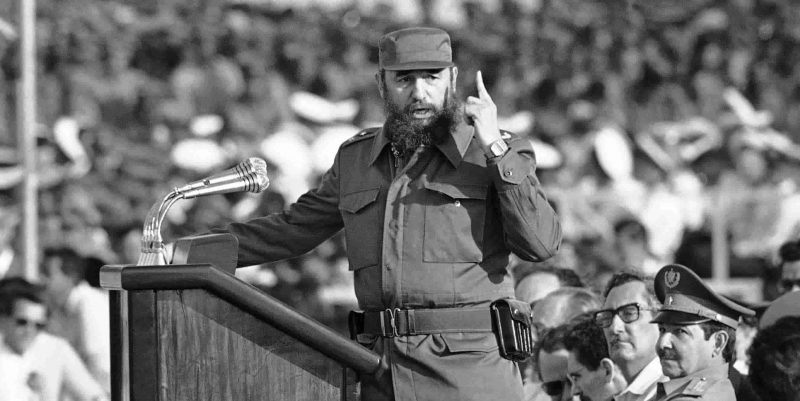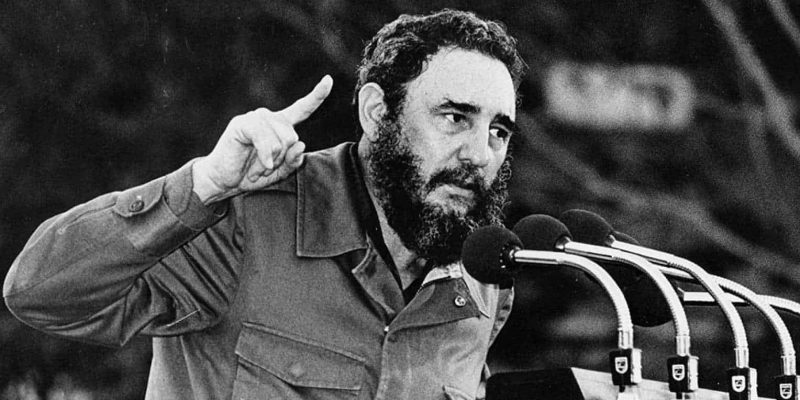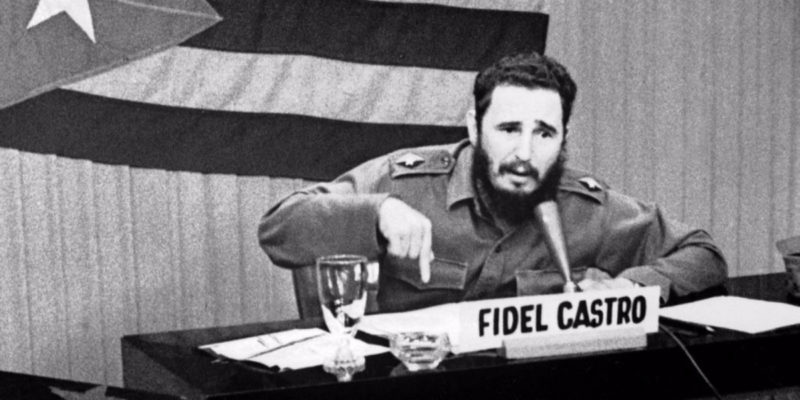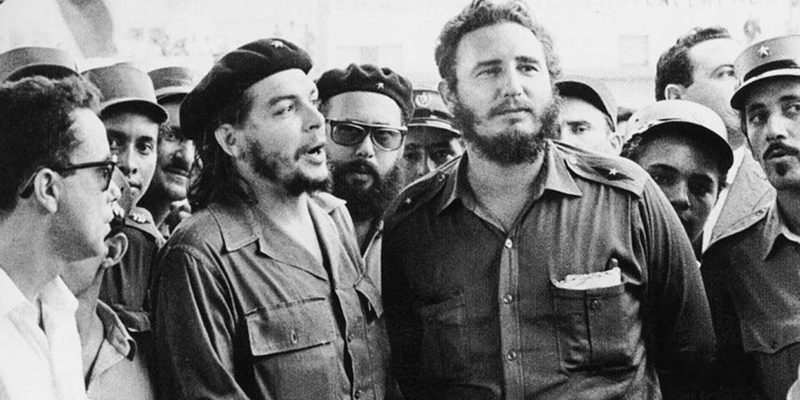We explore Fidel Castro, his youth, and his participation in the Cuban Revolution. In addition, we discuss the characteristics of his government, and death.

Who was Fidel Castro?
Fidel Castro was a Cuban lawyer, military figure, politician, and revolutionary who led the Cuban revolutionary forces that overthrew dictator Fulgencio Batista on January 1, 1959, and established a Marxist-Leninist (communist) regime within a few years. Castro himself ruled Cuba until stepping down from the presidency in 2006 due to ill health and advanced age.
Fidel Castro was one of the most prominent figures in 20th-century world politics, being one of the main architects of the Cuban Revolution, which resulted in the establishment of the first socialist state in the Americas, and aligning himself with the Soviet Union (USSR) since 1960 in the midst of the Cold War.
This alignment quickly alienated him from the United States government, leading to strained diplomatic relations with his neighbors. Castro's Cuba was also the stage for one of the major international crises of the Cold War, known as the Cuban Missile Crisis, in 1962. On the other hand, Fidel Castro's anti-imperialist and Latin Americanist rhetoric drew him closer to other 21st-century leaders in the region, including Hugo Chavez of Venezuela, Néstor and Cristina Kirchner of Argentina, and Evo Morales of Bolivia.
- See also: Che Guevara
Birth and family of Fidel Castro

Fidel Alejandro Castro Ruz was born in Birán, Cuba, on August 13, 1926. He was the natural child of Galician immigrant Ángel Castro Argiz, a prosperous sugarcane landowner, and Lina Ruz, who became his second wife several years after Fidel's birth, following his divorce from María Luisa Argota Reyes.
Fidel Castro had several siblings, among whom Raúl Castro's figure stands out. Along with Fidel, Raúl embarked on the revolutionary path, and assisted him in government as one of his closest associates, having been a communist militant from a young age.
After Fidel's provisional resignation due to ill health in 2006, his brother Raúl took over the government, serving initially as interim president and then officially when Fidel’s resignation became final in 2008, until the election of Miguel Díaz-Canel in 2018.
Fidel Castro had two wives: Mirta Díaz-Balart (from 1948 to 1955) and Dalia Soto del Valle (from 1980 onward), with whom he had six children in total: Fidel Ángel Castro Díaz-Balart, Alexis Castro Soto del Valle, Alexander Castro Soto del Valle, Antonio Castro Soto del Valle, Alejandro Castro Soto del Valle, and Ángel Castro Soto del Valle.
In addition, it is known that he had three children out of wedlock: Alina Castro Revuelta, Jorge Ángel Castro Laborde, and Francisca Pupo.
Youth of Fidel Castro
Fidel Castro received a good education under the Jesuits, and later pursued his studies at the University of Havana, from where he graduated in law in 1950.
During his time as a student, he joined university politics as a class delegate and later as president of the University Committee for Democracy in the Dominican Republic, where he carried out actions to protest against the dictatorial regime of Rafael Leónidas Trujillo in the Dominican Republic.
This path subsequently led him to run for the House of Representatives of the Cuban Congress, but the elections were interrupted by the coup d'état of March 10, 1952, led by Fulgencio Batista.
Fidel Castro's participation in guerrilla warfare

Fidel Castro's attempts to fight through legal means against the dictatorship established by Fulgencio Batista failed, and led him to the conviction that the only solution was armed struggle.
He became organized with other groups of young insurgents and, on July 26, 1953, they attempted an attack on the Moncada Barracks in Santiago de Cuba and the Carlos Manuel de Céspedes Barracks in Bayamo. The assault failed, with several of the insurgents being captured by the regime.
After 22 months in prison, Castro was released along with his comrades in May 1955 thanks to a general amnesty. He then went into exile in the United States and then in Mexico, where he formed the 26th of July Movement and began organizing his revolutionary invasion of Cuba, which he carried out in December 1956 along with Che Guevara, Raúl Castro, Juan Almeida, and Camilo Cienfuegos, among others.
The landing in the south of the island was met with resistance from Batista's troops. The revolutionaries were forced to flee to the jungle, taking refuge in the Sierra Maestra mountains. From there, they began a series of propaganda operations to convince the population to join them in their guerrilla war.
At that point, the revolutionaries came to number around 800 volunteers ready to overthrow Batista, while the regime's army deployed 70,000 soldiers.
Castro's rise to power in Cuba
On January 1, 1959, after months in which rebel troops numbers had been constantly increasing with deserters from the Cuban army, volunteers from various rural towns, and even from major cities, Batista fled to Santo Domingo, aware of his imminent defeat against the revolutionary forces.
Fidel Castro's so-called "barbudos" (bearded ones) took advantage of the situation and, amid a general strike they themselves had called for, captured Santiago and Havana, marking the end of Batista's government.
Government of Fidel Castro
The first years of Castro's government (1959-1961)

The transitional government that emerged in Cuba after the fall of Batista placed Castro at the head of the revolutionary army (mostly composed of his own men), with Manuel Urrutia as president of the country.
Numerous "revolutionary tribunals" were carried out, in which thousands of former officials and collaborators of the Batista regime were executed. With measures slowly veering towards communism, tensions arose between Castro and the presidency. In February 1959, Castro was appointed prime minister and, in July, Urrutia was forced to resign the presidency and go into exile in the United States.
The United States government growingly became alarmed by the expropriation of US companies in Cuba. In 1960, the Cuban government started to forge closer ties with the Soviet Union, with which it signed a trade agreement.
This resulted in the severance of diplomatic relations between the United States and Cuba and the declaration of a US embargo on the Caribbean island in 1961.
Bay of Pigs Invasion (1961)
Castro's establishment of a regime aligned with the Soviet Union meant that most of Cuba's middle classes fled to the United States, where a powerful anti-Castro lobby was formed.
On April 15, 1961, United States President John Fitzgerald Kennedy launched an attempted invasion of the country by Cuban exiles organized by the CIA (the US intelligence agency).
The Bay of Pigs or Playa Girón invasion ended in failure, deepening Castro's alignment with the Soviet bloc. In December 1961, Castro openly proclaimed himself a Marxist-Leninist.
From the Missile Crisis to the Fall of the Soviet Union (1962-1991)
The deployment of Soviet missiles on the island of Cuba and their discovery by US spy planes triggered the Cuban Missile Crisis in 1962, the closest the world has ever come to nuclear war.
Soviet leader Nikita Khrushchev was forced to order the withdrawal of the missiles, representing a major defeat for Castro, who was in favor of confronting the United States. Nonetheless, he remained loyal to the Soviet Union and, in 1968, supported the Soviet invasion of Czechoslovakia.
From then onward, Castro became one of the standard bearers of the Third World against "US imperialism". Despite the trade embargo imposed by the United States, the Cuban economy, heavily subsidized by the Soviet Union, allowed him to make some social advances and to initiate an active international policy in support of guerrilla movements in Latin America and the sending of troops to Angola (1975) and Ethiopia (1977).
The fall of the Soviet Union in 1991 left him in a marginal position at the head of one of the few surviving communist dictatorships. The disappearance of Soviet aid precipitated the collapse of the Cuban economy, which entered what came to be known as the "Special Period". Castro had to open the country to tourism and foreign investment, while continuing a harsh repression against all forms of dissidence.
End of Castro's government (1991-2008)
Castro ruled Cuba until 2008, though in 2006 he had been forced to temporarily hand over control to his brother Raúl due to health problems. He survived the fall of the Soviet Union and the end of the Cold War.
His government was the first communist regime in Latin America, taken as a model by anti-imperialist movements worldwide. At the same time, it was heavily criticized by international public opinion due to its authoritarian nature and the systematic persecution of dissidence and homosexuality.
Castro's relationship with Che Guevara

Fidel Castro and Ernesto "Che" Guevara met in Mexico in 1955, when Fidel and his brother Raúl were preparing the 1956 revolutionary invasion of Cuba. Raúl became a friend of the Argentine revolutionary and introduced him to his brother. Thus began an alliance that led Guevara to join the Cuban communist guerrilla movement, becoming one of its most prominent figures.
Guevara became part of Fidel Castro's revolutionary government, serving in various positions such as President of the National Bank of Cuba, director of the Department of Industrialization of the National Agrarian Reform Institute, and Minister of Industry.
In addition, he led various Cuban diplomatic missions, remaining in Cuba until 1964, when he decided to assist revolutionary forces in other countries in Africa and Latin America.
Convinced of the need to export the revolution, Che traveled to the Congo, Angola, and finally Bolivia, where he was captured and executed in 1967.
His remains were actively sought by the Cuban government until 1997. That year, they were taken to Santa Clara, Cuba, where they rest in the Ernesto Guevara Memorial alongside other guerrilla leaders.
Death of Fidel Castro

Fidel Castro died on November 25, 2016, in Havana at the age of 90. The cause of his death was not disclosed, though he had been away from public life for several years due to ill health and advanced age.
His body was cremated, and his ashes were entombed in the Santa Ifigenia Cemetery, in Santiago de Cuba.
Fidel Castro quotes
Among Fidel Castro's most famous quotes are:
- "By studying capitalism, I became a communist."
- "A revolutionary can lose everything: family, freedom, even life, except morality."
- "We were born in a free country that our parents bequeathed to us, and the Island will first sink into the sea before we consent to be the slaves of anyone."
- "Whoever is not capable of fighting for others will never be capable of fighting for himself."
- "They talk about the failure of socialism, but where is the success of capitalism in Africa, Asia and Latin America?"
Explore next:
Was this information useful to you?
Yes NoThank you for visiting us :)